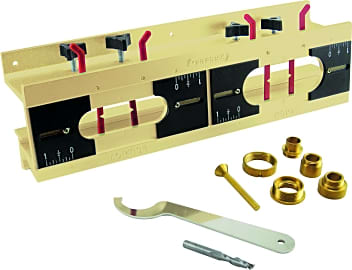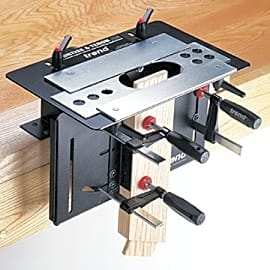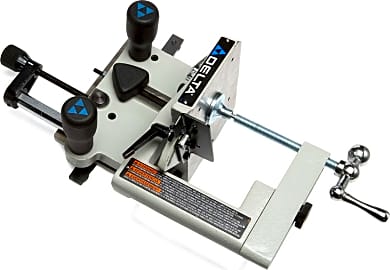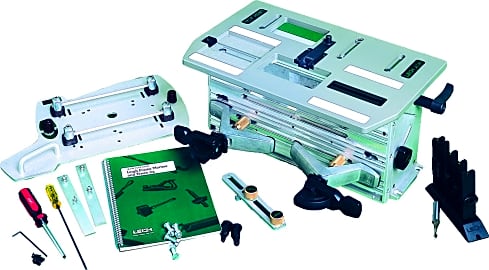The 6 Best Tenoning Jigs

This wiki has been updated 41 times since it was first published in March of 2015. Having the right tools means easier and faster results for any project. These tenoning jigs allow you to create tight-fitting joints, offer superior accuracy on a table saw, and save you time between cuts. They're perfect for making custom furniture, such as cabinets, dressers and desks. We've included both professional quality models and those perfect for the home DIYer. When users buy our independently chosen editorial recommendations, we may earn commissions to help fund the Wiki.
Editor's Notes
May 28, 2021:
The WoodRiver 2801 and a ShopFox right angle jig got the axe because they're no longer available. Instead, we suggest the Grizzly Industrial T30491 as the new top model, which is very similar to the WoodRiver in terms of durability and consistency. One thing you might notice when browsing for a tenoning jig is that many seem to be identical copies of the Grizzly. Some might be, but we decided on the Grizzly due to positive professional and long-term user reviews.
The rest of our listings remain the same. We still like the Trend MT/JIG for light-duty applications, although it may not hold up to commercial use. The General Tools 870 is another great choice for hobbyists, largely because it doesn't require a table saw.
Of course, if you're making tenons, you might also be in the market for a quality mortising machine.
February 20, 2020:
Removed the Powermatic PM-TJ because of availability issues. Removed the Oshlun 6-Inch, the Scribe-Master Cope-Pro, and the Trend Varijig because of a category mistake. The Oshlun is a set of Dado blades for table saws - not a jig. The Scribe-Master is a jig used to cope patterns on mouldings and other trim - it is not usable for making tenons. Makers of the Trend Varijig claim that it can be used to make tenons but looking at the design, it is clear that it cannot be said to be a jig for making tenons - at most, it may facilitate making mortises.
Added the WoodRiver 2801, the Delta 34-184, and the Grizzly Industrial H7583.
A tenon is half of the classic mortise-and-tenon joint that is ubiquitous in woodworking. A tenoning jig is mostly known as a tool that holds wood stock perpendicular to the top of a table saw - it is essentially a moving fence. Many of the jigs we have included like the WoodRiver 2801 and the Shop Fox W1500 can be used on both table saws and benchtops, although, a simple woodworker's vise is ideal when hand-cutting tenons. The WoodRiver's face and rail are perfectly parallel. This is perhaps the most essential feature a tenoning jig can have since even a small deviation can result in unusable or ugly tenons.
Working with wood creates fine particles that are hazardous if inhaled. Use breathing protection to avoid health complications.
The Ancient Art Of Woodworking
The Chinese were renowned for joinery that didn't use glue or nails, instead relying on ingenuity and engineering to hold objects together.
Wood is one of the oldest and most important substances to humanity. It was the first dense fuel used for fires, made up the first tools, and still to this day helps to house billions of people. Humans initially used wood for primitive tools such as clubs and digging sticks, though woodworkers began to craft more complex items such as folding stools as early as the 14th century B.C.E. Simple stones such as flint were the first woodworking implements, and as woodworking developed, craftsmen moved on to increasingly resilient materials such as copper and bronze.
The ancient Egyptians are well-known for their prowess with wood, thanks not only to many drawings depicting the workers and the structures they built; researchers in the last 100 years have uncovered and excavated huge numbers of finely-crafted wooden artifacts, many of which are in exceptional shape, thanks to being locked up underground for thousands of years, away from sunlight, intense heat, and moisture. For that reason, some Egyptian specimens have given insight into the advanced, yet archaic techniques used so long ago.
Among the most impressive pieces of carpentry ever recovered, the Khufu Ship was a ceremonial boat likely used during King Cheops' burial rites. While it lacks the trappings of a functional sailing ship, anthropologists agree that it would almost certainly float, and as such it may have been used as the final vessel to take the King to the afterlife. It was disassembled and interred in Khufu's tomb, only to be painstakingly reconstructed by scientists thousands of years later. Today, it lives in a museum and represents the oldest window we have into the skillful technique of Egyptian woodworkers, and displays similar fastener-less joints to those still made today.
While the Khufu Ship was possibly the largest, complete wooden artifact ever recovered, the title of oldest goes to some shockingly well-preserved architecture in the city of Leipzig, just southwest of Berlin. Amazingly, these specimens have been around since 7000 B.C.E., and they owe much of their longevity to their mortise-and-tenon design.
The Romans and Chinese of antiquity are two other civilizations renowned for prolific and high-end woodwork. Ancient Rome left very few wooden artifacts for modern anthropologists to study, but there are many volumes written about topics such as how to craft and join wooden parts, and even which trees make the best lumber, as well as how to grow them. The Chinese were renowned for joinery that didn't use glue or nails, instead relying on ingenuity and engineering to hold objects together. Such fastener-less construction was then and still is a highly respected way to construct wooden items.
Tools Of The Trade
The axe and its relative the adze were among the earliest metal tools, and were often joined in a double-headed configuration that later inspired the pickaxe. Roman engineering introduced a wealth of new and useful tools, such as forged nails, the claw hammer, a precursor to the hacksaw, the wood plane, the auger, and more. The focus of carpentry shifted during Europe's Dark Ages and medieval times, when large portions of human knowledge and technology were forsaken following the utter collapse of the Roman Empire. Artistic endeavors continued, such as incredibly intricate carvings based on Christian concepts, but advanced woodworking dropped off significantly during this period, much like written history itself. Construction did continue faster than ever, though, as citizens and military alike built more and more structures to house themselves and reinforce defenses.
By the 16th century, carpentry began to explode thanks to the proliferation of British sawmills. Government and investors took steps as bold as the founding of the American colonies, partially to gain more resources for ship-building. Volume and efficiency ramped up during the Industrial Revolution, as innovations like the steel circular saw and cut nails made woodworkers' jobs easy. But no matter how complex technology became, a nearly 10,000-year-old technique remained one of the most popular and effective joint configurations.
Now That's Quite the Joint
While unfamiliar to many non-carpenters, tenons are actually quite simple. They're somewhat akin to inserting a plug into an outlet; the male end (the tenon) is honed to fit into the female end (the mortise) at a 90-degree angle, and with an absolute minimum of play. Today, these joints are often secured with dowel rods, nails, or glue. The real magic of this joint, however, is in the most expert projects; an exceptionally skilled carpenter can craft mortise and tenon joints so exact that they result in a rock-solid structure without using any fasteners whatsoever. In fact, the joint's high strength leads to its use in many large, load-bearing structures, even including small buildings.
While unfamiliar to many non-carpenters, tenons are actually quite simple.
In modern times, the Amish are well-known for their high standards and devotion to handcrafting — both of which apply directly to the mortise and tenon. If, unlike the Amish, you're open to using power tools, there are two specific means to creating a near-perfect joint using modern accessories. One type of apparatus is built to fit with certain standardized table saws. This configuration holds the wooden framing in place at a predetermined angle, and the entire assembly moves along the table saw. It's a relatively quick way to shave off extraneous material, although table saws tend to have somewhat wide clearances.
Alternately, smaller projects that require extremely close tolerances generally call for a router-based jig. These units affix to a workbench or other solid surface and hold the unfinished frame securely in their center. The exact position of the wood is set, and the carpenter uses a router to carve the plank into a tenon. This method takes a bit longer than simply running a specimen across a table saw, but it can result in significantly higher strength, sometimes without the need for glue or nails. Whatever size your project, and whichever tool you use to complete it, knowing how to create a quality mortise-and-tenon joint is a basic skill the mastery of which will benefit any woodworker, whether beginner or expert.











